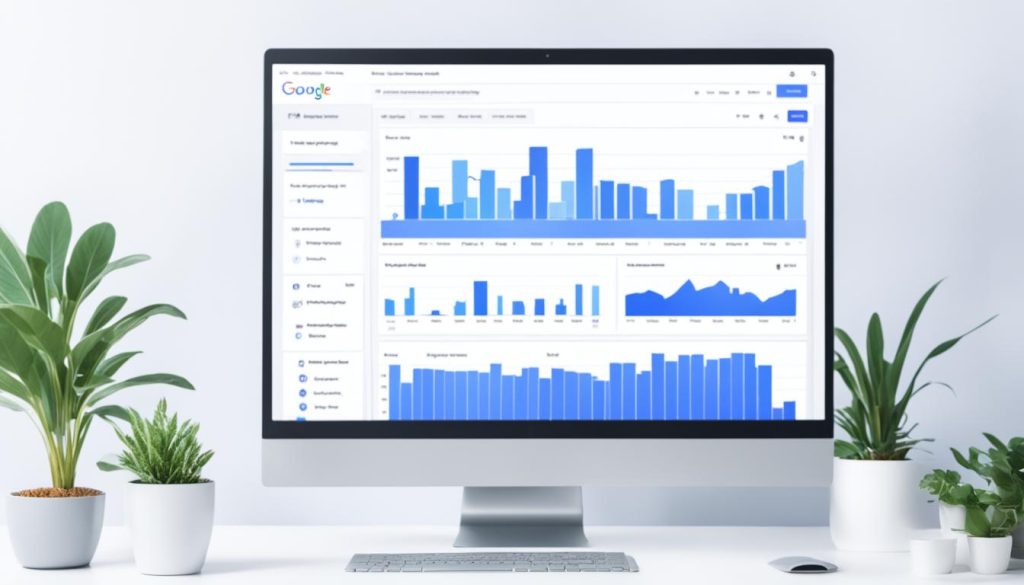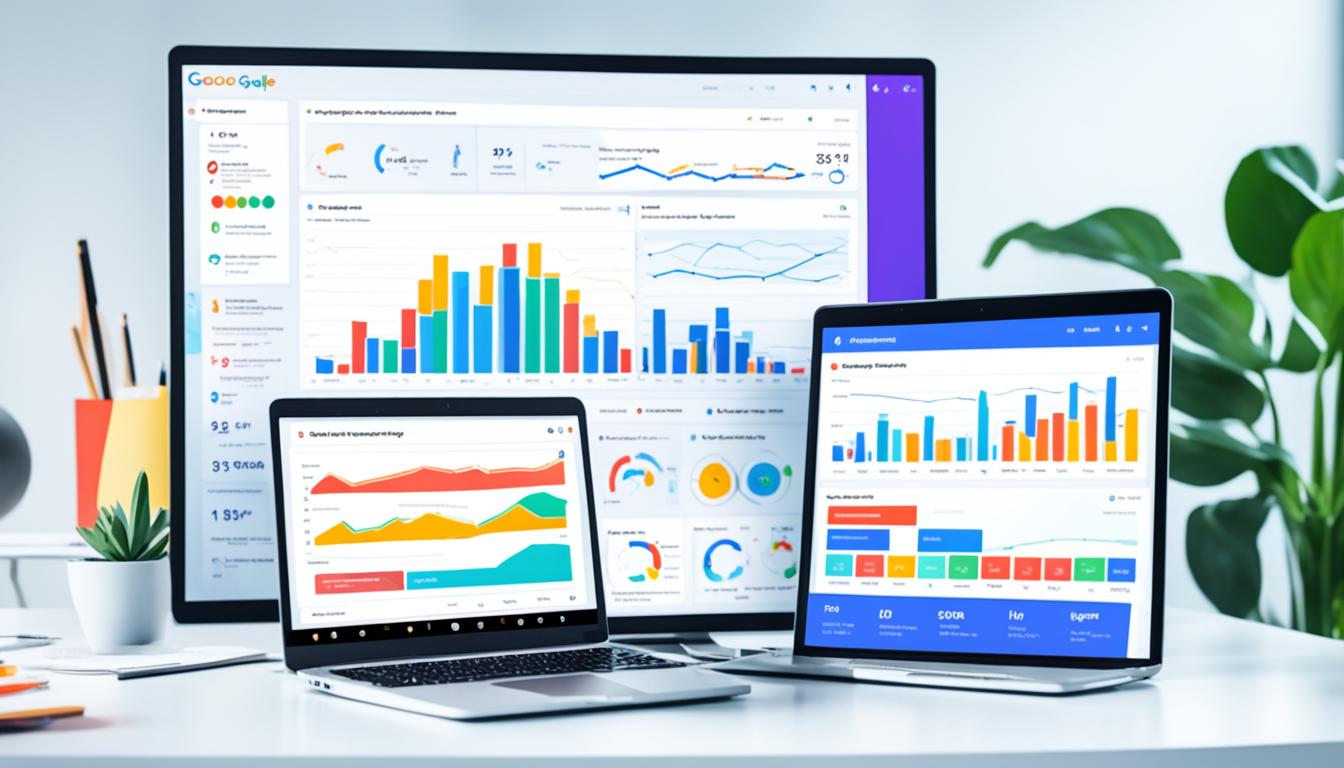Are you looking to take your online advertising strategy to the next level and drive business growth? Look no further than Google Business Ads Manager. Formerly known as Google AdWords, this powerful platform offers a range of features and tools that can help you optimize your ad performance and reach a large audience.
With Google Business Ads Manager, you can choose from various ad formats and targeting options to ensure that your ads are seen by the right people at the right time. Whether you want to increase website traffic, generate leads, or boost sales, this platform provides the flexibility and precision you need to achieve your goals.
By utilizing the Google Business Ads Manager effectively, you can take your online advertising strategy to new heights. With precise targeting, careful budgeting, and constant monitoring, you can maximize the potential of your ads and achieve better conversion rates.
Key Takeaways:
- Google Business Ads Manager is a powerful platform for online advertising.
- It offers various ad formats and precise targeting options.
- Understanding and utilizing the Google Business Ads Manager can drive business growth.
- Optimizing ad performance through targeting, budgeting, and monitoring is crucial.
- With Google Business Ads Manager, you can maximize the potential of your ads and achieve better conversion rates.
Understanding Google Ads
Google Ads, formerly known as Google AdWords, is a versatile online advertising platform that allows businesses to display ads on Google’s search engine results pages and partner websites. It offers a variety of ad formats, including text ads, display ads, and video ads.
Google Ads provides precise targeting options, allowing businesses to reach their desired audience based on factors such as location, demographics, and interests. With millions of daily searches on Google, businesses can tap into a massive audience and increase their online visibility through Google Ads.
Whether you’re a small local business or a multinational corporation, Google Ads provides the tools and resources to help you achieve your advertising goals. By utilizing this powerful platform, you can create effective ad campaigns, drive targeted traffic to your website, and generate valuable leads.
To give you a better understanding of the features and benefits of Google Ads, let’s take a closer look at some key elements below:
Ad Formats
Google Ads offers a range of ad formats to cater to different campaign objectives and audience preferences. Text ads are the most common format and appear as clickable headlines and descriptions on Google search results pages. Display ads, on the other hand, are visually appealing banners that can be displayed on various websites across the Google Display Network. Video ads, as the name suggests, allow businesses to showcase their products or services through engaging video content.
Precise Targeting
One of the greatest strengths of Google Ads is its precise targeting capabilities. Instead of taking a shot in the dark, businesses can define their target audience based on location, demographics, interests, and other relevant factors. This means that your ads will be shown to people who are more likely to be interested in your products or services, increasing the chances of conversion.
Massive Audience
Google is the world’s most popular search engine, with billions of searches conducted daily. By advertising on Google Ads, businesses can tap into this massive audience and increase their online visibility. Whether you’re looking to reach local customers or expand your brand globally, Google Ads provides the platform to connect with millions of potential customers.
“Google Ads provides a versatile online advertising platform with various ad formats, precise targeting options, and a massive audience. By harnessing its power, businesses can effectively promote their products or services, reaching their desired audience and maximizing their online advertising potential.”
With its user-friendly interface and powerful features, Google Ads is an essential tool for businesses looking to grow their online presence and drive valuable results. In the next section, we will guide you through the process of setting up your Google Ads campaign, ensuring you have a solid foundation for success.
Setting Up Your Google Ads Campaign
The first step to unlocking the potential of Google Ads is to create an account and set up your campaign. By defining clear goals and objectives, you can ensure that your campaign aligns with your overall marketing strategy. Whether your aim is to increase website traffic, generate leads, or boost sales, having a clear direction is essential.
Google Ads offers a range of targeting options to help you reach your desired audience. By considering factors such as demographics, interests, and keywords, you can optimize your ad targeting and ensure that your message reaches the right people at the right time.
Let’s take a closer look at the key steps to set up your Google Ads campaign:
Step 1: Create a Google Ads Account
To get started, visit the Google Ads website and create an account. Once you’ve provided the necessary information, you’ll have access to the Google Ads Manager, where you can set up and manage your campaigns.
Step 2: Define Your Campaign Goals and Objectives
Before launching your campaign, it’s crucial to define your goals and objectives. This step will help you stay focused and measure the success of your ads. You may want to increase brand awareness, drive website traffic, generate leads, or increase sales. By setting clear objectives, you can design your campaign to achieve those specific goals.
Step 3: Choose Your Targeting Options
Google Ads provides various targeting options that allow you to reach your ideal audience. You can target users based on their location, demographics, interests, or even specific keywords. Consider your target market and tailor your targeting options accordingly to ensure that your ads are displayed to the right people.
Step 4: Set Your Budget and Bidding Strategy
Determining your advertising budget is a crucial step in setting up your Google Ads campaign. Consider how much you’re willing to spend and allocate your budget accordingly across different campaigns and ad groups. Additionally, choose the bidding strategy that aligns with your goals and budget, whether it’s manual CPC (Cost per Click) or automated bidding.
Step 5: Create Compelling Ad Copies
Once you’ve defined your campaign settings, it’s time to create your ad copies. Craft compelling headlines and ad descriptions that capture the attention of your target audience. Incorporate relevant keywords that align with your campaign’s objectives to improve your ad’s visibility in search results.
Step 6: Launch Your Campaign and Monitor Performance
After setting up your campaign, launch it and closely monitor its performance. Keep a close eye on key metrics such as impressions, clicks, click-through rates, and conversions. Utilize tools like Google Analytics to gain valuable insights and make data-driven decisions to optimize your campaign.
By following these steps and setting up your Google Ads campaign strategically, you can maximize its effectiveness and achieve your desired outcomes. Remember, clear goals and objectives, combined with precise targeting options, are the foundation of a successful Google Ads campaign.

| Steps | Description |
|---|---|
| Step 1 | Create a Google Ads Account |
| Step 2 | Define Your Campaign Goals and Objectives |
| Step 3 | Choose Your Targeting Options |
| Step 4 | Set Your Budget and Bidding Strategy |
| Step 5 | Create Compelling Ad Copies |
| Step 6 | Launch Your Campaign and Monitor Performance |
Crafting Compelling Ad Copies
Creating compelling ad copies is crucial for capturing the attention of your target audience. Your ad headlines should be attention-grabbing, enticing users to click on your ad. The success of your ad heavily relies on its headline, as it acts as the first impression for potential customers. It is essential to craft headlines that are engaging, informative, and aligned with the user’s search intent.
When creating ad descriptions, it’s important to keep them concise yet persuasive. Use compelling language to highlight the unique value proposition of your products or services. Understand what makes your offering stand out and communicate it succinctly. Emphasize the key benefits and features that differentiate your business from competitors. Showcasing a clear and compelling value proposition can greatly impact the performance of your ads.
Another crucial aspect of crafting ad copies is incorporating relevant keywords into your content. By aligning your ad copy with the search terms people are using, you can enhance your visibility in search results. Conduct thorough keyword research to identify the most relevant and high-performing keywords for your business. Incorporate these keywords strategically into your ad copies while ensuring that they flow naturally and remain informative.
By investing time and effort into crafting compelling ad copies, you can increase the click-through rate and improve the overall performance of your Google Ads. Remember to continually monitor and optimize your ad copies based on performance data to achieve even better results.
Key Tips for Crafting Compelling Ad Copies:
- Create attention-grabbing headlines that align with user search intent.
- Keep ad descriptions concise yet persuasive, highlighting your unique value proposition.
- Incorporate relevant keywords strategically into your ad copy.
- Regularly monitor ad performance and optimize based on data.

| Benefits of Crafting Compelling Ad Copies |
|---|
| Increased click-through rate |
| Better visibility in search results |
| Improved ad performance |
| Higher conversion rates |
Designing Eye-Catching Visuals
When it comes to Google Ads, visuals can make all the difference in capturing the attention of your audience. By incorporating impactful images into your ads, you can create a visually engaging experience that resonates with users and drives campaign effectiveness.
“A picture is worth a thousand words.” – Unknown
One of the keys to designing eye-catching visuals is branding consistency. Consistency in branding helps to establish a strong visual identity and build brand recognition. It is essential to maintain a consistent color palette, typography, and overall design aesthetic across your ads. This consistency not only creates a cohesive visual experience but also strengthens brand recall in the minds of your audience.

The placement of impactful images should be strategic, ensuring they complement the ad copy and add value to the overall message. Whether it’s showcasing your products, illustrating your services, or evoking emotions associated with your brand, visuals can play a powerful role in capturing attention and increasing engagement.
Branding Consistency:
To ensure branding consistency in your Google Ads, consider the following:
- Use your brand logo in a prominent position within the ad.
- Choose images that align with your brand values and messaging.
- Stick to a consistent color palette that reflects your brand colors.
- Apply consistent typography across your ads, using fonts that are in line with your brand style.
Impactful Images:
Here are some tips to create impactful images for your ads:
- Focus on high-quality images that are clear and visually appealing.
- Consider using images that evoke emotions or tell a story related to your products or services.
- Choose images that are relevant to your target audience and resonate with their interests and preferences.
- Experiment with different image formats, such as static images, gifs, or videos, to find what works best for your campaign.
Remember, strong visuals can significantly enhance the effectiveness of your Google Ads and increase your brand’s visibility. Invest time and effort in designing eye-catching images that align with your branding and engage your audience.
| Benefits of Eye-Catching Visuals | How Visuals Enhance Campaign Effectiveness |
|---|---|
| 1. Captures attention | 1. Increases ad visibility |
| 2. Engages emotions | 2. Drives higher user engagement |
| 3. Reinforces brand identity | 3. Enhances brand recall and recognition |
| 4. Provides context and understanding | 4. Improves message comprehension |
Budgeting and Bidding Strategies
Setting an advertising budget is a crucial step in managing your Google Ads effectively. By establishing a budget that aligns with your goals, you can ensure that your advertising spend is optimized to drive maximum results.
When determining your advertising budget, it’s important to consider factors such as your business objectives, target audience, and competition in the market. By understanding how much you’re willing to invest in your advertising efforts, you can allocate your funds strategically to achieve the best return on investment (ROI).
Once you have set your advertising budget, it’s time to select the right bidding strategy. Google Ads offers different bidding options, each with its own benefits and considerations. Whether you choose manual cost-per-click (CPC) bidding or automated bidding, it’s essential to understand how each strategy works and its impact on your ad performance.
Manual CPC Bidding
With manual CPC bidding, you have full control over your bids, allowing you to set the maximum amount you’re willing to pay for each click on your ads. This bidding strategy is recommended for advertisers who want complete control over their budget and keyword-level bids. It enables you to adjust your bids based on the performance of your keywords and allocate your budget to the most valuable clicks.
Automated Bidding
Automated bidding is a smart approach that utilizes machine learning to optimize your bids automatically. Google Ads’ automated bidding strategies include target CPA (cost-per-acquisition), target ROAS (return on ad spend), and maximize conversions, among others. These strategies leverage historical data to predict and adjust bids, aiming to achieve your desired campaign objectives while maximizing your ROI.
By leveraging automated bidding strategies, you can save time and effort while allowing the system to adapt and learn from your campaign performance. It’s important to monitor and evaluate the performance of your automated bidding strategy regularly to ensure it aligns with your goals and delivers the desired outcomes.
Regardless of the bidding strategy you choose, it’s crucial to continually monitor and optimize your Google Ads campaigns. By reviewing key metrics, such as click-through rate (CTR), conversion rate, and cost per conversion, you can identify areas for improvement and make data-driven decisions to enhance your ad performance.
Strategically managing your advertising budget and selecting the right bidding strategy can help you maximize your ROI and drive the desired results for your business. With a well-planned budget and effective bidding techniques, you can ensure that your ads reach the right audience and achieve optimal performance.

Monitoring and Analyzing Performance
Monitoring the performance of your Google Ads campaigns is crucial for achieving ongoing success in your online advertising strategy. By utilizing tools like Google Analytics, you can gather valuable insights into the effectiveness of your ads and make data-driven decisions to optimize your advertising efforts.
Google Analytics is a powerful platform that allows you to track key metrics such as impressions, clicks, and conversions. These metrics provide a comprehensive view of your campaign’s performance and help you understand how users are interacting with your ads.
One key metric to monitor is impressions, which gives you an indication of how many times your ads have been shown to users. By tracking impressions, you can assess the reach and visibility of your ads among your target audience.
Clicks are another important metric to analyze. They measure the number of times users have clicked on your ads, indicating their engagement and interest. By monitoring clicks, you can evaluate the effectiveness of your ad copy, targeting, and overall campaign strategy.
Conversions, or the desired actions taken by users after clicking on your ads, are a critical metric in assessing the success of your campaign. Whether it’s making a purchase, filling out a form, or signing up for a newsletter, tracking conversions enables you to evaluate your ad’s impact on driving valuable actions.
With Google Analytics, you can gain a deeper understanding of your audience’s behavior, demographic information, and more. This data can be used to refine your targeting options and tailor your ads to better resonate with your audience.
By regularly monitoring and analyzing the performance of your Google Ads campaigns, you can identify areas for improvement, optimize your ad performance, and make informed decisions based on data. This data-driven approach ensures that your online advertising efforts are aligned with your business goals and leads to more effective and successful campaigns.
Optimizing for Conversions
Conversion tracking and A/B testing are two essential strategies for optimizing your Google Ads campaigns and achieving better conversion rates.
Implementing conversion tracking allows you to measure the success of your ads by tracking the actions users take, such as making purchases or submitting forms. By understanding which ads are driving conversions, you can focus your efforts on the most effective campaigns and make data-driven decisions to continuously improve your results.
A/B testing, on the other hand, enables you to experiment with different ad variations and landing pages to identify the elements that lead to better conversion rates. By testing and comparing different aspects of your ads, such as headlines, visuals, or call-to-action buttons, you can uncover insights and refine your strategy for maximum impact.
By leveraging conversion tracking and A/B testing, you can optimize your Google Ads strategy and achieve better conversion rates, ultimately driving more valuable actions and increasing the success of your online advertising efforts.
FAQ
What is Google Business Ads Manager?
How can Google Business Ads Manager help my business?
What are the features of Google Ads Manager?
How do I set up a Google Ads campaign?
What should I consider when crafting ad copies for Google Ads?
How important are visuals in Google Ads?
How should I set my advertising budget and choose a bidding strategy?
How can I monitor and analyze the performance of my Google Ads campaigns?
How can I optimize my Google Ads for better conversions?
Source Links
- https://medium.com/@onlinemillionaire63/unlock-your-online-potential-claim-500-free-google-ads-credits-today-26167d4b139b
- https://www.linkedin.com/pulse/unlocking-power-google-ads-sangita-chambugong-wpgdc
- https://www.linkedin.com/pulse/google-ads-unlocking-power-online-advertising-sharif-mtztf?trk=public_post_main-feed-card_feed-article-content




No comments! Be the first commenter?